Wildlife Removal Blog - A Trapper's Journal
This weblog chronicles some of the adventures I have had while operating my wildlife removal company in Orlando, FL - Click any of the photos for a larger image and more information.
I currently have 351 blog entries. You can select them sorted as such:
2003 •
2004 •
2005 •
2006 •
2007 •
2008 •
Armadillo •
Bat •
Bird •
Dead •
Opossum •
Rat •
Snake •
Squirrel •
Others •
Repairs •
All Entries
10.18.2004 - Iguana Control in Orlando Florida
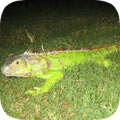 |
|
| Orlando is swimming with iguanas! They're coming out of the sewers! Marching in giant packs across our fields! Slithering across our highways! Invading our libraries and schools! Eating all of our crops! Scaling the roof of your home! Coming up through your toilet! Eating your children in the night! Well, these are exaggerations. They are merely nibbling at your children in the night. Still, there are iguanas in Orlando. I catch them from time to time. For example, I caught one today. There it is. In the above photo. Looking smart. This iguana was just sitting in the c...click for more |
10.31.2005 - Florida Iguana Removal
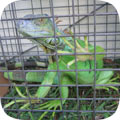 |
|
| I received a call about an iguana on the roof of a home. I consider this type of call an "immediate response" situation, because if I do not address the matter immediately, I likely won't have a chance to do so in the future. For example, many snake removals require immediate attention, before the snake slithers off and is lost. However, a case of squirrels living in the attic can wait a day, since the situation will not change day to day. In the case of this iguana, I knew that I would have to arrive quickly, or the iguana would climb down and run off. I am often unable to address the ...click for more |
10.10.2006 - Florida Exotic Species - Iguana, Burmese Python
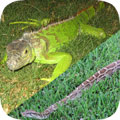 |
|
| One of the more common sensationalist topics in the field of wildlife management is that of exotic species. Exotic means non-indigenous, or non-native species. In particular, people are interested in large and scary critters such as giant lizards and snakes. In my field of nuisance wildlife control, I come across exotics commonly. The above photo shows two of the interesting exotics that I've dealt with over the years: the iguana, which is native to Central and South America, and the Burmese Python, which comes from southeast Asia. I caught these animals in suburban ...click for more |
09.22.2006 - Florida Red Fox
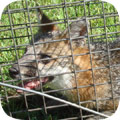 |
|
| Look at this foxy animal. It's a fox. A Florida Red Fox. A Vulpes vulpes fulva. Of course, it happens to be mostly gray in color. But then, I've seen Eastern Gray Squirrels that are red in color. Color names are
often misleading. It's true that I once saw a dog named Old Yeller, and the thing was in fact yeller, but I also once saw a dog named blue, and the thing was boring old brown. I've even seen rednecks whose necks
were in fact a pasty peach color. You can't always trust a name. But this Florida Red Fox is in fact a fox in Florida, so the name is 2/3 correct. ...click for more |
01.26.2006 - Project at SeaWorld Orlando
 |
|
| I took these photos of killer whales at SeaWorld in Orlando. This was during a bat removal project. A colony of Brazilian Free-Tail bats was living in the jumbotron structure overlooking the main display
tank at the Shamu Stadium. SeaWorld usually uses a specific company for their wildlife and bat removal needs, but this particular project was deemed too difficult for their regular bat removal company, so I was called in.
The job was unique for a number of reasons. First of all, the tower was surrounded by ....water. Ladders don't hold as steady on water as they ...click for more |
01.01.2006 - Fight! Raccoon versus Opossum
 |
|
| Ladies and gentlemen! In the blue corner, weighing in at 11 pounds, making his debut fight, please welcome our challenger, Pete "I Don't Play Dead" Possum! And in the gold corner, weighing in at 14 pounds, our current champion, give it up for Ricky "Rocky" Raccoon! Touch paws
gentlemen, I want a good, clean fight! There's the opening bell, I expect they'll just look at each other as always AND HOLY CRAP THEY'RE ABOUT TO TEAR EACH OTHERS THROAT OUT STOP THE FIGHT STOP THE FIGHT, in goes the metal divider, and it's all over
a ...click for more |
12.31.2003 - Bobcat Trapping
 |
|
| I set armadillo traps at a house in a suburban community on the east side of Orlando. I had trapped an armadillo already, but the customer wanted me to continue trapping, in case there were more. The yard suffered from significant
armadillo digging. I got a call on the morning of the 31st, from the owner of the house, and she told me that one of the cages contained a large and aggressive cat. "I think it's a bobcat", she said. "Suuurree… it's a bobcat", I thought. The customer
is always telling me about wild and crazy animals that do not exist. Every harmless little Corn Snake ...click for more |
05.07.2005 - Florida Redbelly Turtle
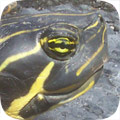 |
|
| I am unsure of the exact species of turtle here. I believe that it is a Florida Redbelly Turtle. It might be a type of Cooter turtle. I found it while working on a bat project in Saint Petersburg. I was working on a building when I
found it walking along the parking lot. The entire area was fenced in. I'm not sure if the animal was stuck or migrating to a new area. I often wonder how slow animals like this can migrate to new areas, but I suppose that slow and steady wins the race.
I didn't see any good habitat areas on the condo property, but the turtle must have come ...click for more |
11.17.2004 - Frog Removal, Control, Get Rid of Frogs
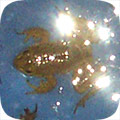 |
|
| This was certainly one of my more unusual jobs. A lady called me, stating that her swimming pool was full of frogs, and she asked me if I could remove them. Although this was uncharted territory for me, the fact is that many of my jobs are
actually uncharted territory, and this didn't sound terribly difficult. I figured that I'd show up, and by hook or by crook, I'd catch those frogs and save the day. So we scheduled a time and I showed up, but I soon realized that I needed neither hook nor crook,
but rather a net. I had some nets, but the size of the pool made the skimmer a fair ...click for more |
07.27.2006 - Cuban Tree Frog in Florida
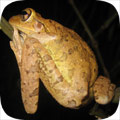 |
|
| These frogs are everywhere here in Orlando Florida. When I arrive at a house, I often see them perched on the walls or atop the door, or light fixture, or many other areas. When I conduct an inspection of the roof, I often find several more. I routinely
see them down inside the plumbing stacks of homes. For the most part, they are harmless. However, some people simply don't like frogs, or even have phobias, so from time to time I am called to address frog issues. I've had a couple of cases of frog-in-the-toilet, and I
think that the frogs may have gone down the ...click for more |
09.01.2005 - Crab Removal
 |
|
| I was working on a bat removal project in Hobe Sound Florida, when something caught the corner of my eye. It was an odd shape and color, and it was moving unlike anything I'd ever seen before. "What in the hell is that?" I thought. I walked over
for a closer look, and was amazed to see this crab. I do not know the species, but I believe it might be some sort of fiddler crab. The fact is that I had no idea that I was close to any body of salt water. In fact, I was still over a mile from the ocean. In addition,
this house was surrounded by a large stone wall, so I didn't ...click for more |
04.04.2005 - Fox Removal
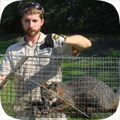 |
|
| Every now and then I catch a fox. Such as today. Today I caught a fox. I never intend to catch a fox. They simply wander into my trap. I usually bait with non-meat items, so as not to attract cats. My target species for this size of a trap,
usually raccoons, opossums, or armadillos, do not need meaty bait. Yet foxes are lured into the traps regardless. I don't know if they're simply scavenging up the marshmallow (or whatever I've used) bait, or if they can smell the scent of a previously caught opossum,
but I've caught several foxes. I like foxes. They're shy ...click for more |
09.07.2006 - How To Remove Cats in the Attic
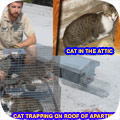 |
|
| Cats in the attic! Cats in the attic! All I keep hearing about is cats in the attic. Meowing and scratching! Prowling and mouse catching! Howling and rat snatching! Well, not howling so much. But yeah, cats in the attic. I remove
all kinds of wild animals from attics: raccoons, squirrels, opossums, rats, bats, and even cats. Most of the time, the customer hears scratching and scampering and clawing in the attic. But sometimes they also hear mewing. If they hear mewing, I have reason
to suspect that they have cats, for cats howl and mew. If they do have cats, what ...click for more |
08.03.2004 - Kittens in the Attic - How To Get Them Out
 |
|
| A female feral cat, like any other wild critter, wants a safe place to have her young. So pretty much every time (but not 100% of the time), when I have a call for cats in the attic, there's also some kittens somewhere. It's important to
find the kittens, and to check the female cat, if you've caught her without kittens, for swollen cat-teets, which indicate nursing. Believe it or not, kittens drink milk. Who would have thought? So in this case, I searched and searched for a litter of kittens,
and sure enough, I found them, huddled in a ball in the insulation. They looked cute! But ...click for more |
09.18.2004 - Florida Gopher Tortoise
 |
|
| I simply found and photographed and then released this fine specimen. The Florida Gopher Tortoise, Gopherus polyphemus is, like most torti, slow. However, unlike most tortoises, it can dig really f'ing well. It digs these amazing
burrows, which are like, fifteen feet deep or more. Several wildlife species, such as the rare Indigo Snake, use these burrows for refuge. Unfortunately, the Gopher Tortoise is in trouble. As usual, habitat loss is the problem. There's a lot of land development
here in Florida, and much of the land previously used by the turtles is now ...click for more |
04.03.2006 - Toad Mating
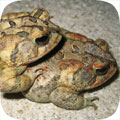 |
|
| I found these fine toads while working in a bat removal project in Heathrow, FL. I don't know what species of toad they are. They're not the regular Eastern Toad, even though that's what they look like, since the range of that toad does not extend
to Florida. I liked how these toads were clearly good pals. They were nearly inseparable. At one point they actually tried to play a game of leapfrog! However, the one frog couldn't quite hop over the other. He tried and tried, but just couldn't make it. The
other frog didn't seem to mind.* Anyway, I took these in-good ...click for more |
01.19.2004 - Alligator Removal in Orlando Florida
 |
|
| As a wildlife removal specialist working in the state of Florida, I hear the same initial reaction from northerners again and again. When I tell that what I do for a living, the first thing out of their mouth
is, "Wow, so you mean, you trap gators and (stuff)?" Gators, gators, gators, that's all anyone cares about, is gators. No doubt the sensationalist stylings of Steve Irwin the Crocodile hunter, and other such critter mavericks
on TV have taught people to think that every fellow who dons a khaki shirt and goes after wild animals is wrestling six gators before lunch. The ...click for more |
11.30.2006 - Guinea Hen Capture
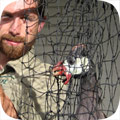 |
|
| Now here's a new catch! A Guinea Hen! I suspect that this fine bird was someone's pet, and then it either escaped or was abandoned. Either way, it wound up living on the steps at an apartment complex that I regularly service. This time, instead of
removing squirrels from the attic 3-stories high, I removed this feathery friend. Apparently the maintenance crew tried repeatedly to catch it and chase it away, but it stubbornly resisted capture and chasing, and had been living on a particular flight of stairs for
approximately a week, and thus I was called onto the sc ...click for more |
08.24.2006 - Groundhog Trapping
 |
|
| Groundhog trapping, in Florida of all places? No, I have to admit that I did not trap this groundhog at all. It was captured by my good friend Bruce, who lives on Massachusetts. The critter was digging under his porch and eating his plants, and
he finally decided that it had to go. He called me to ask for my expert advice. I carefully described a trap consisting of an apple under cardboard box propped up by a stick to which a string is tied. Bruce is so trusting, that he set up said configuration, and waited
many frustrating hours patiently waiting for the groundhog ...click for more |
11.28.2006 - Green Anole
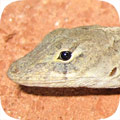 |
|
| The Green Anole, (Anolis carolinensis) is also called the Carolina Anole. It lives in the southeast US and throughout Florida. This small lizard can grow to about eight inches. Males are larger than females and have a throat fan, or dewlap. This lizard
can change color to match its background, and they eyes can move independently, like a chameleon. They eat a variety of small prey, mostly insects. If attacked, they can detach their tail in hopes that a predator will go for that as opposed to the more
vital parts. They can live up to seven years in captivity, but probably ...click for more |
07.02.2005 - Florida Lizards
 |
|
| When I was a small child, I loved to collect reptiles and amphibians. The sight of a mere toad filled me with a sort of brilliant and breathless thrill that winning the lottery today would not nearly match. It'd be hard to describe
just how much, at my tender young age, I longed to catch and possess the creepy crawly critters of the world, particularly if they were covered in scales. So at the age of four years old, my family took a vacation to Disney World Resorts in Orlando. During
that trip, I made all sorts of innocent four-year-old discoveries, such as the day I dug a deep ...click for more |
01.01.2006 - Five Lined Skink
 |
|
| The Five Lined Skink, (Eumeces fasciatus), also known as the Blue Tail Skink, is a small lizard that lives throughout much of the eastern United States. Skinks are characterized by a lack of neck, a smooth tubular body, and short
legs. They squiggle along when they move. As either of their common names imply, this lizard has five bright lines tracing down its back and tail, and the tail is blue. The colors are more pronounced in younger lizards, and can fade with age, particularly in
the male lizards. I think this lizard is very pretty. It has the sort of fancy colours more ...click for more |
12.01.2003 - Stray Cat Trapping
 |
|
| Nothing in my industry of nuisance wildlife control incites more controversy than stray cat control. The problem is that cats, (Felis catus) exist in basically two forms. There's the domesticated housecat and beloved pet, and then there's
the stray, or feral, cat which is often, for all intents and purposes, a nuisance wildlife species. I've observed many feral cats, living under dumpsters, in the woods, junkyards, and other unsavory places, and their behavior is no different than that of raccoons, opossums,
or rats. In fact, the cats are usually dirtier and more aggressive. The ...click for more |
07.09.2005 - Florida Softshell Turtle
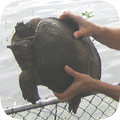 |
|
| Today I saved this Florida Softshell Turtle (Apalone ferox). I was enjoying a peaceful Sunday afternoon, my first time off in 74 days. Suddenly, I heard a knock at my front door. A concerned citizen had found a trapped soft shell turtle! He saw
that I had a truck marked "wildlife removal" in my driveway, and he thought that perhaps I could help. "Of course I'll help!" I said, putting down my lemonade and setting aside my book. I followed him out to a nearby lake in downtown Orlando. Sure enough, there, in a
fenced-in section next to the lake, sat a Florida Soft Shell Turtle. ...click for more |
04.22.2003 - Mole Capture & Removal
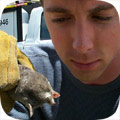 |
|
| Moles are a common nuisance animal throughout the country. The primary objection that homeowners have to this little creature is that they make a mess of lawns. They live underground, where they are extremely active, tunneling through soil and eating
about half their body weight each day in earthworms and grubs and such. They dig deep tunnels, which aren't noticed, but they also dig surface tunnels for both feeding and movement, and these tunnels create ridges all over a lawn. In addition, moles often dig deep chambers
in which to live or nest, and they often push ...click for more |
06.06.2004 - Eastern Mole Control
 |
|
| The Eastern Mole (Scalopus aquaticus) is common throughout most of the eastern United States, from Canada all through Florida. This little critter only grows to about 6.5 inches in total length, and 3 oz. in weight. It has no ears or eyes,
as you can see in the above photo, but it may be able to detect light. Moles, of course, live underground, where they dig a network of tunnels. They burrow through the soil in search of earthworms and grubs, and they can dig very quickly. They are very energetic, and
they eat a lot, about half of their body weight each day. ...click for more |
11.11.2008 - Raccoon Drawing
 |
|
| A couple of years ago I rescued a baby raccoon, as I commonly do. I put the photos of this raccoon on my website, as I also commonly do. The photos are located here cute baby raccoons if you want to see them.
Anyway, a nice lady named Susan Smith wrote to me and asked if she could use my photos as inspiration to paint some wildlife pictures, and I said of course. I thought nothing of it until months later, when she emailed me a nice scan of a painting that she
made out of one of my photos. I have put her painting and the original photo side by side for compar ...click for more |
10.06.2003 - Wild Animal Trapping in Orlando Florida
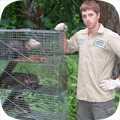 |
|
| I am most pleased to be a wildlife removal specialist in Orlando FL. I trap and remove nuisance wild animals from people's homes and property. Most commonly, I deal with raccoons, opossums, armadillos, squirrels, snakes, & bats. When it comes to catching
animals in large cages, such as shown in the above photo, it's mostly raccoons, opossums, and armadillos. In the above photo, I have a stack of four cages with raccoons, and one opossum. I caught the first raccoon at a house in which the raccoon was pooping in the customer's
pool. I simply set a ...click for more |
10.22.2004 - Trapping Wild Animals of Orlando Florida
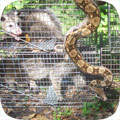 |
|
| Here's today's catch of wild animals in Orlando Florida. As you can see, I caught a large Boa Constrictor snake! I also caught two opossums and two raccoons. I got the Boa at a residential neighborhood yard, where the homeowners saw the snake slithering along.
I removed it for no charge. I got the first opossum from inside a garbage can - it had climbed in and couldn't get out! I snared it and put it into a trap. I got the second opossum from a trap that I set at the crawlspace entrance of a home.
I caught it with orange slices, which possums often seek out for the ...click for more |
10.01.2005 - Wildlife Career - Removing Problem Animals
 |
|
| I am very happy to have a career as a nuisance wildlife removal specialist. Many people ask me for jobs. Perhaps 100 or so people per year, in fact, find my website and request employment. I operate alone, so I must tell all of them that
I'm not hiring. To be honest, the majority of the requests are from guys that sound like uneducated rednecks, and they cite their wildlife experience as their love of snakes. That's about a third of the requests. Some of the others are just guys that are looking
for a job, any job. Then another large chunk of job requests are from people that ...click for more |
09.22.2006 - Wildlife Jobs in Florida
 |
|
| If you are seeking a job working with wildlife in Florida, there are several options. You can work for a local county animal services, where you will deal mostly with dogs and cats. You can work with the Florida Wildlife Commission, where you
will probably not get a job, and if you do, it'll probably be something specialized, or perhaps a desk job. I'm not sure. Contact them at www. floridaconservation .org. You can
also seek to be employed by a privately owned wildlife removal business. There are several such businesses in Florida, such as Skunk Busters, Kreature Katch, Trap ...click for more |
05.07.2004 - Wildlife Management In Orlando Florida
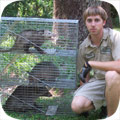 |
|
| I don't often describe my job as a wildlife management specialist, but apparently that's what some people call it. I suppose wildlife management is synonymous with wildlife control, which is a term I use more frequently. I will talk about my
wildlife management work in the state of Florida, but most of all, I want to talk about my awesome hair in this photo. It's like, all awesome and Prince Valliant and rocking.
I like the blonde highlights and the poofiness and everything that makes it the best wildlife management hair ever, hair that is capable of slaying ten or ...click for more |
10.11.2006 - Wildlife Rescue in Orlando Florida
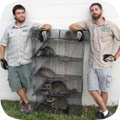 |
|
| If you are seeking wildlife rescue for a wild animal in Orlando, you probably won't get free help to rush on out and take care of it for you. There are some wildlife rehab centers and individuals operating in the Orlando area, but
they don't do house calls. You have to bring the animal in to them. One of the frustrating aspects of running my own wildlife removal business is that many people call me thinking that I'm some government sponsored agency, and that I will come to the
property for free to take care of some wildlife malady. Many of these callers assume that the ...click for more |
07.03.2003 - Wildlife Trapping in Orlando Florida
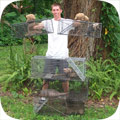 |
|
| If you need wildlife trapping in Orlando Florida, I'm your guy! I'm the rootinest-tootinest critter gitter in all of Florida, yee-haw! I've caught raccoons and squirrels, both boys and girls, from coast to coast, with taters and toast! I catch
them mangy musky muskrats, those skiving squirrels, and those tasty armadillos by the bucketload. I'm armed with a steel trap and an itchy snare pole finger, and I can smell a dead skunk from your mother in law with but one whiff of my bloodhound snout. It's late and I'm
tired and I'm just writing gibberish, because I want to go ...click for more |
12.29.2003 - Rodent Trapping in a Cage
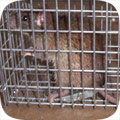 |
|
| Wow! Here's a first! A Roof Rat and and Eastern Gray Squirrel in one cage! I was called out to a home that had scratching in the ceiling. Most of the noises were heard in the morning and evening, so I suspected that it was squirrel
activity. I inspected the home, and found multiple entry points at the eave gaps and in holes chewed in the soffit. I sealed up the entire home and installed heavy-duty steel screen on the soffit areas, so that no more squirrels could get in. I left
the two primary entry holes open, so that I would not seal any animals inside (where they'd desperately ...click for more |
07.11.2007 - Tokay Gecko In Florida
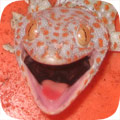 |
|
| We got a call about a very strange sound that came from the walls of a home every night. We get calls about animal noise all the time - that's usually the first symptom of animal infestation that people notice. However, most of the sounds are standard
scurrying or scratching in the attic. Sometimes people hear running on the roof, and sometimes they hear the chattering of baby raccoons. However, in this case they heard a loud croaking/squawking sound and a tooting not unlike a kazoo. It was driving them crazy and keeping
them awake all night. At a loss for wh ...click for more |
01.06.2004 - Orlando Wildlife Rehabilitation
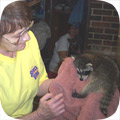 |
|
| I'd like to introduce you to a wonderful woman. Her name is Lee Harr. For more than ten years now, she's operated a wildlife rehabilitation facility out of her own home. She pays all of the expenses out of her own savings. Her goal is
to care for injured, sick, and orphaned wild animals. From raccoons to squirrels to birds and almost anything, she has a wonderful gentle touch and understanding of wildlife, and a relentless drive to help wild critters. She works non-stop, 16 hours a day,
seven days a week, and she absolutely loves animals. She takes a no-nonsense ...click for more |
08.15.2007 - Bat Poop - Droppings & Waste in an Attic
 |
|
| The biggest problem with a colony of bats living in the attic is that they poop a lot. If the group of bats is very large, the waste can really build up.
Some colonies of bats are over 1000 members in number. Each bat makes about 6-8 bat turds per day. They live in the attic year-round. That means a lot of bat
crap. In the above photo, a small group of 40 bats were living in an attic. They roosted across the length of the attic ridge, but most of the bats roosted in one
area. Below that lay a pile of bat droppings, or guano, as seen in the above photo. This is a relatively ...click for more |
08.20.2003 - Opossum Poop - Droppings & Waste in Attic
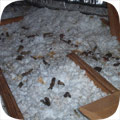 |
|
| Wow, this was a messy attic. Opossums had been living in this attic for a few months. The homeowner procrastinated doing anything until the noise
and the smell got to be too much to handle any longer. I came to the home and found several sections of a flimsy soffit screen torn open, and the opossums could easily
climb up adjacent trees and downspouts and into the attic. Opossums are messy animals, and they poop wherever they want. They poo a lot, and their terds are the size of a dog's turds. This
attic was filled, from end to end, with possum drop ...click for more |
11.19.2004 - Squirrel Poop - Droppings & Waste in an Attic
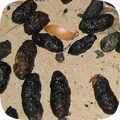 |
|
| Here is a close-up photo of squirrel poop. I took it from an un-insulated section of attic space, or essentially, above a ceiling in a house that was
filled with squirrels. The squirrels left thousands of droppings sprinkled throughout the attic, but this was just one tiny area. Most of the squirrel turds in this
area are pretty fresh. Though some are old, you can see that they are drier or have mold growing on them. It's often hard to distinguish between squirrel and rat droppings. Squirrel
droppings are just slightly larger, and slightly shorter with more rounded ends. But it's not ...click for more |
03.12.2006 - Rat Poop Droppings & Waste in Attic
 |
|
| Here are two different photos of rat poop in an attic. On the left is a heavily-used rat pathway in an attic with blown-in fill insulation. On the right
is a section of scattered droppings in pink insulation. Both attics had a heavy rat infestation, and thousands of droppings scattered throughout. Rats have very
high metabolisms, and they poop a lot perhaps about 20 rat turds per day. Thus, they leave a lot of rat waste in the attics where they live. They also urinate, and the pheromone scent in the
urine and perhaps even the poo attracts new rats to the area. There is one ...click for more |
03.12.2005 - Raccoon Poop - Droppings & Waste in an Attic
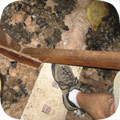 |
|
| Holey mackerel, this attic was a mess! I don't know if you can see very well in this photo, but the whole place was filled with huge piles of raccoon
poop. The insulation used to be pink, but now it's mostly brown from mud and urine stains, and the buildup of raccoon poo is tremendous. This is just one section of
the attic, but the whole attic was filled with raccoon waste. It smelled terrible. This home was in the Pine Hills, in a run down house, and I think the raccoons must have been using this attic for
years. The raccoons had access to many wide-open entry points. This job ...click for more |
01.21.2007 - Pigeon Droppings & Waste in an Attic
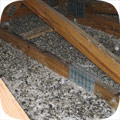 |
|
| Everyone knows that pigeons poo. You can see lots of their waste in any city in America, particularly under the areas in which they roost. However,
poop outside tends to wash away with the rain. In this case, pigeons were living inside an attic of a home, and it just doesn't rain as hard inside attics, and thus the
poop accumulated. This pigeon waste buildup happened over only a few months - or so I'm told by the customer, though the birds could have been up there longer than
suspected - and I found only five birds in the attic. I guess pigeons poop a lot! I flushed ...click for more |
01.01.2006 - Mole Poison
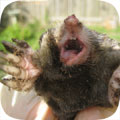 |
|
| "Blargh!", said the above mole as it gasped its last breath before dying. This mole was murdered. But how? BY POISON! Yes, mole poison
killed this mole. I know, because I poisoned it myself. I invited this mole to a fancy dinner, but little did he know that I placed cyanide in his wine. Just
a few sips, and he keeled over as I cackled with laughter. This mole will dig up my yard no more. Of course the above story is fictitious. I actually used
iocane powder. Okay, I didn't use poison at all. There is no such thing as an effective mole poison. I say effective, ...click for more |
01.01.2006 - Mole Trapping
 |
|
| If you have a problem with moles destroying your yard, there is only one way to get rid of the problem - with mole traps. There is absolutely no effective
mole poison, repellent, deterrent, or any device to easily get rid of them. Except for a trap. Just set the mole trap on the surface mole tunnels, trap and remove
the mole or two in your yard, and you'll have digging no longer. Unfortunately, mole trapping is not easy. The traps are not very user friendly. There are
several types of mole traps, from harpoon to scissor (shown above) to underground clamp traps, but ...click for more |
01.01.2006 - Mole Extermination
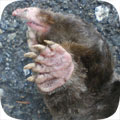 |
|
| This is a nice photo of a Townsend's Mole, taken in the Seattle area by my friend Sean. He traps and removes moles. I don't really do any mole
extermination here in Florida. It's not worth my time, and frankly, I just never got good at it. Mole control is difficult. Even for me, who did it for a
while in Pennsylvania and experimented in Florida. Unfortunately, there is no quick and easy way to exterminate moles. Many people want to buy poison to kill
moles. The problem is that moles eat only live food - almost entirely earthworms, and they won't eat anything inanimate, ...click for more |
01.01.2006 - Flying Squirrel Removal
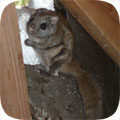 |
|
| Flying squirrels are rodents, like all squirrels. They don't actually fly, but glide on flaps between their front and hind legs. They are nocturnal
animals, and they are colonizing - they live in groups. They usually live in trees, just like the Gray Squirrels, but just like the Grays, they love to live inside of
attics. If you have flying squirrels in the attic, you will notice noise at night, since that's when these animals are active. They will leave the house at dark
and forage, and come back a few times, and retire by morning. They don't make quite as much noise as their larger ...click for more |
01.01.2006 - How To Get an Animal Out of a Tree
 |
|
| The man in this photograph is not me. In fact, it might not be a man at all - more like a monkey. I'd never make a climb this high or dangerous, let
alone with a snare pole in hand, let alone back down with a struggling raccoon on the end! But that's what my friend Sean did to catch this raccoon in a tree. The
customer called because this particular raccoon has been causing trouble. Breaking into the attic, tipping over the garbage can, and always out and about during the day
threatening her dogs, and so on. So when she saw it, Sean came out to catch it, and it ran up a ...click for more |
01.01.2006 - Big Brown Bat Photograph
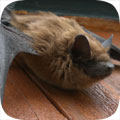 |
|
| This is a detail photograph of a Big Brown Bat (Eptesicus fuscus). The Big Brown is a common bat involved in nuisance wildlife removal, because like
the Little Brown Bat, it's a colonizing mammal that likes to live in buildings. It looks fairly similar to the Little Brown Bat, except it's ...bigger. It has a
wingspan of maybe 10 inches and it weighs 5/8 oz, which while small, is quite a bit larger than your average colonizing bat. I don't deal with Big Brown Bats here in
Florida. I deal with the Freetails and the Evening Bats. The Big Brown is more common up north. This photo ...click for more |
01.01.2006 - Skunk Control
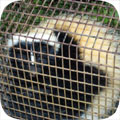 |
|
| This is not a photograph that I took. Someone else took it for me. The reason is because I don't get any skunk calls here in Orlando Florida.
It's too bad. I like skunks. I even like their scent. I have a thing for skunk scent. But I haven't smelled it down here, not even on the highways.
Up north in Pennsylvania, where I grew up, skunks were common, and every few miles down the road I had the pleasure of sniffing one. Alas, such is not the case here.
I did do a fair amount of skunk control and trapping while I was training as a wildlife removal specialist ...click for more |
02.18.2006 - City Raccoon - Urban Raccoon Control
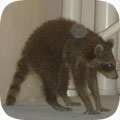 |
|
| Cities are chock-full of raccoons. It's this way not only down here in Florida, but all over the country. Raccoons have become urbanized city
dwellers. They used to stay only in the undeveloped forests. But raccoons are intelligent and adaptable animals, and they have learned that cities make a great
place to live. There's plenty of tasty garbage and pet food to eat, not to mention that handouts that some people insist on giving them (a dumb thing to do, and
ultimately unkind to animals). And there's also lots of great places to live that are far better than trees. From under ...click for more |
12.25.2006 - Christmas Squirrel - Ben Saves the Day
 |
|
| 'Twas the night before Christmas, when all through the house. A creature was stirring, a rat squirrel or mouse. The stockings were hung by the
chimney with care, but unfortunately of people the apartment was bare. The squirrels were all nestled all safe in their beds, while visions of peanuts danced in their
heads. Alas one poor squirrel did not make a peep, because it was stuck in a permanent sleep. Thus from the walls arose such an odor, that Ben jumped in his truck and
turned on the motor. The stench in the house from the walls that arose, gave the luster of ...click for more |
03.11.2007 - Raccoon Snare - Snaring an Animal
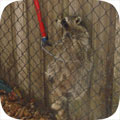 |
|
| Raccoon sure manage to get themselves into all sorts of trouble! This one somehow got itself lodged between a chain link fence and a wooden fence.
This was a really tight spot! I don't know how it happened, but this raccoon was stuck fast. We were called out to the scene. The easiest way to remove wild
animals from tight spots is usually with a snare pole - it's a pole with a plastic-coated metal cable that can tighten around the animal. Many animal control officers use
such a device. We were called out, and the property owner wanted the raccoon removed ...click for more |
11.19.2006 - Trapper Apprentice - Learning How To Trap Wildlife
 |
|
| I have a new apprentice training with me. His name is Ben, and already he's shaping up to be a fine wildlife removal specialist. He's demonstrated a
willingness to climb into hot attics, crawl under dirty homes, and sniff out dead animal carcasses. He doesn't mind getting his hands dirty, that's for sure! Here's
a list of the traits that make a good wildlife trapper apprentice: Common Sense - Probably the most important thing, outside of being a good person, and
not everyone has it of course. I don't care if someone has a fancy pants degree in wildlife biology. ...click for more |
10.25.2006 - Wildlife Relocation
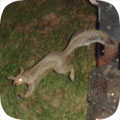 |
|
| Here is Tim, releasing some squirrels into a wildlife preserve area. These animals were caught and removed from an attic in a suburban home.
We perform live trapping and relocation of all our wildlife that we catch, so long as it's legal to do so. We always strive to put the animals under the least amount of
stress possible. We never leave animals in the sun, we don't leave them in traps for long, and we always relocate them same day. However, what is the right way to
relocate wildlife? It's possible that we are in fact putting them under a lot of stress by tak ...click for more |
04.05.2006 - Removal of a Critter in the Attic
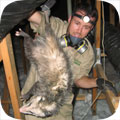 |
|
| Sean and I went to this home today because the customer was hearing noises above his head, and he suspected that he had a critter in his attic. We climbed
the garage ladder hatch and entered the attic, with gloves, headlamps, and dust masks, as usual, and began our inspection. We found plenty of tracks and opossum
droppings, so we knew what critter we were dealing with. Most of the time, we never actually spot the animals in the attic. They quietly hide in the deepest darkest
corners when they sense a potential danger, and they are tough to find. So that's ...click for more |
03.11.2006 - Critter Trapper Education
 |
|
| I was playing darts over Christmas with my new brother-in-law Sean, when he started asking me about my career as a nuisance wildlife removal specialist.
It told him that it was by far the best job I've ever had, and that I look forward to each day. Sean was doing a boring manager's job at the time, and when I described to
him the trapping in attics and wrassling with snakes, that's all he needed to hear, and he asked if he could sign on and train with me, so that he could start his own business
in his home town of Seattle. I told him sure, come on down to Sunny Florida and ...click for more |
09.11.2006 - Critter Catcher in Training
 |
|
| Ah, yet another disgruntled software engineer who's decided to take a walk on the wild side. I myself used to be a software developer, hating my life
behind the desk staring at a computer screen (oh wait, that's what I'm doing at this very moment), but when I discovered the fun of working outside catching critters, I haven't
looked back. My friend Tim decided that he'd like to do the same thing, so now he's down here with me in Florida, training to be a critter catcher himself. He wants
to open his own operation in Portland after six months or so with me. Tim is one of ...click for more |
|


